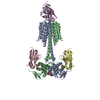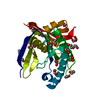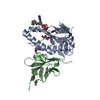+ Open data
Open data
- Basic information
Basic information
| Entry | Database: PDB / ID: 7yz9 | ||||||||||||
|---|---|---|---|---|---|---|---|---|---|---|---|---|---|
| Title | Structure of catalytic domain of Rv1625c bound to nanobody NB4 | ||||||||||||
 Components Components |
| ||||||||||||
 Keywords Keywords | SIGNALING PROTEIN / Membrane Adenylyl Cyclase / Nanobody / Complex / Mycobacterium Tuberculosis | ||||||||||||
| Function / homology |  Function and homology information Function and homology informationreceptor guanylyl cyclase signaling pathway / peptide receptor activity / cGMP biosynthetic process / guanylate cyclase activity / adenylate cyclase / cAMP biosynthetic process / adenylate cyclase activity / manganese ion binding / intracellular signal transduction / magnesium ion binding ...receptor guanylyl cyclase signaling pathway / peptide receptor activity / cGMP biosynthetic process / guanylate cyclase activity / adenylate cyclase / cAMP biosynthetic process / adenylate cyclase activity / manganese ion binding / intracellular signal transduction / magnesium ion binding / ATP binding / plasma membrane Similarity search - Function | ||||||||||||
| Biological species |  Mycobacterium tuberculosis H37Rv (bacteria) Mycobacterium tuberculosis H37Rv (bacteria) | ||||||||||||
| Method |  X-RAY DIFFRACTION / X-RAY DIFFRACTION /  SYNCHROTRON / SYNCHROTRON /  MOLECULAR REPLACEMENT / Resolution: 1.97 Å MOLECULAR REPLACEMENT / Resolution: 1.97 Å | ||||||||||||
 Authors Authors | Khanppnavar, B. / Mehta, V.J. / Iype, T. / Korkhov, V.M. | ||||||||||||
| Funding support |  Switzerland, 3items Switzerland, 3items
| ||||||||||||
 Citation Citation |  Journal: Elife / Year: 2022 Journal: Elife / Year: 2022Title: Structure of Cya, an evolutionary ancestor of the mammalian membrane adenylyl cyclases. Authors: Ved Mehta / Basavraj Khanppnavar / Dina Schuster / Ilayda Kantarci / Irene Vercellino / Angela Kosturanova / Tarun Iype / Sasa Stefanic / Paola Picotti / Volodymyr M Korkhov /  Abstract: adenylyl cyclase (AC) Rv1625c/Cya is an evolutionary ancestor of the mammalian membrane ACs and a model system for studies of their structure and function. Although the vital role of ACs in cellular ... adenylyl cyclase (AC) Rv1625c/Cya is an evolutionary ancestor of the mammalian membrane ACs and a model system for studies of their structure and function. Although the vital role of ACs in cellular signalling is well established, the function of their transmembrane (TM) regions remains unknown. Here, we describe the cryo-EM structure of Cya bound to a stabilizing nanobody at 3.6 Å resolution. The TM helices 1-5 form a structurally conserved domain that facilitates the assembly of the helical and catalytic domains. The TM region contains discrete pockets accessible from the extracellular and cytosolic side of the membrane. Neutralization of the negatively charged extracellular pocket Ex1 destabilizes the cytosolic helical domain and reduces the catalytic activity of the enzyme. The TM domain acts as a functional component of Cya, guiding the assembly of the catalytic domain and providing the means for direct regulation of catalytic activity in response to extracellular ligands. | ||||||||||||
| History |
|
- Structure visualization
Structure visualization
| Structure viewer | Molecule:  Molmil Molmil Jmol/JSmol Jmol/JSmol |
|---|
- Downloads & links
Downloads & links
- Download
Download
| PDBx/mmCIF format |  7yz9.cif.gz 7yz9.cif.gz | 152.3 KB | Display |  PDBx/mmCIF format PDBx/mmCIF format |
|---|---|---|---|---|
| PDB format |  pdb7yz9.ent.gz pdb7yz9.ent.gz | 111.7 KB | Display |  PDB format PDB format |
| PDBx/mmJSON format |  7yz9.json.gz 7yz9.json.gz | Tree view |  PDBx/mmJSON format PDBx/mmJSON format | |
| Others |  Other downloads Other downloads |
-Validation report
| Summary document |  7yz9_validation.pdf.gz 7yz9_validation.pdf.gz | 901.4 KB | Display |  wwPDB validaton report wwPDB validaton report |
|---|---|---|---|---|
| Full document |  7yz9_full_validation.pdf.gz 7yz9_full_validation.pdf.gz | 907.2 KB | Display | |
| Data in XML |  7yz9_validation.xml.gz 7yz9_validation.xml.gz | 16 KB | Display | |
| Data in CIF |  7yz9_validation.cif.gz 7yz9_validation.cif.gz | 22.1 KB | Display | |
| Arichive directory |  https://data.pdbj.org/pub/pdb/validation_reports/yz/7yz9 https://data.pdbj.org/pub/pdb/validation_reports/yz/7yz9 ftp://data.pdbj.org/pub/pdb/validation_reports/yz/7yz9 ftp://data.pdbj.org/pub/pdb/validation_reports/yz/7yz9 | HTTPS FTP |
-Related structure data
| Related structure data |  7yziC  7yzkC  4p2fS S: Starting model for refinement C: citing same article ( |
|---|---|
| Similar structure data | Similarity search - Function & homology  F&H Search F&H Search |
- Links
Links
- Assembly
Assembly
| Deposited unit | 
| ||||||||||||
|---|---|---|---|---|---|---|---|---|---|---|---|---|---|
| 1 |
| ||||||||||||
| Unit cell |
| ||||||||||||
| Components on special symmetry positions |
|
- Components
Components
-Protein / Antibody , 2 types, 2 molecules AB
| #1: Protein | Mass: 28202.803 Da / Num. of mol.: 1 Source method: isolated from a genetically manipulated source Source: (gene. exp.)  Mycobacterium tuberculosis H37Rv (bacteria) Mycobacterium tuberculosis H37Rv (bacteria)Strain: ATCC 25618 / H37Rv / Gene: cya, Rv1625c, MTCY01B2.17c / Production host:  |
|---|---|
| #2: Antibody | Mass: 13771.179 Da / Num. of mol.: 1 Source method: isolated from a genetically manipulated source Source: (gene. exp.)   |
-Non-polymers , 4 types, 161 molecules 






| #3: Chemical | | #4: Chemical | #5: Chemical | ChemComp-ONM / | #6: Water | ChemComp-HOH / | |
|---|
-Details
| Has ligand of interest | Y |
|---|---|
| Has protein modification | Y |
-Experimental details
-Experiment
| Experiment | Method:  X-RAY DIFFRACTION / Number of used crystals: 1 X-RAY DIFFRACTION / Number of used crystals: 1 |
|---|
- Sample preparation
Sample preparation
| Crystal | Density Matthews: 2.35 Å3/Da / Density % sol: 47.67 % |
|---|---|
| Crystal grow | Temperature: 293.15 K / Method: vapor diffusion, sitting drop / pH: 5.5 / Details: 0.1 M Na-acetate pH 5.5, 0.02 M CaCl2, 30% MPD / PH range: 5.0-6.5 |
-Data collection
| Diffraction | Mean temperature: 90 K / Serial crystal experiment: N |
|---|---|
| Diffraction source | Source:  SYNCHROTRON / Site: SYNCHROTRON / Site:  SLS SLS  / Beamline: X06SA / Wavelength: 0.999879 Å / Beamline: X06SA / Wavelength: 0.999879 Å |
| Detector | Type: DECTRIS EIGER X 16M / Detector: PIXEL / Date: Feb 1, 2020 |
| Radiation | Protocol: SINGLE WAVELENGTH / Monochromatic (M) / Laue (L): M / Scattering type: x-ray |
| Radiation wavelength | Wavelength: 0.999879 Å / Relative weight: 1 |
| Reflection | Resolution: 1.97→47.4 Å / Num. obs: 774280 / % possible obs: 93.96 % / Redundancy: 35.9 % / Biso Wilson estimate: 44.58 Å2 / CC1/2: 1 / Rmerge(I) obs: 0.09 / Net I/σ(I): 25.4 |
| Reflection shell | Resolution: 1.973→2.044 Å / Redundancy: 22.8 % / Rmerge(I) obs: 1.587 / Mean I/σ(I) obs: 1.5 / Num. unique obs: 1492 / CC1/2: 0.685 / % possible all: 66.85 |
- Processing
Processing
| Software |
| |||||||||||||||||||||||||||||||||||||||||||||||||||||||||||||||||||||||||||||||||||||||||||||||||||||||||
|---|---|---|---|---|---|---|---|---|---|---|---|---|---|---|---|---|---|---|---|---|---|---|---|---|---|---|---|---|---|---|---|---|---|---|---|---|---|---|---|---|---|---|---|---|---|---|---|---|---|---|---|---|---|---|---|---|---|---|---|---|---|---|---|---|---|---|---|---|---|---|---|---|---|---|---|---|---|---|---|---|---|---|---|---|---|---|---|---|---|---|---|---|---|---|---|---|---|---|---|---|---|---|---|---|---|---|
| Refinement | Method to determine structure:  MOLECULAR REPLACEMENT MOLECULAR REPLACEMENTStarting model: 4P2F Resolution: 1.97→44.07 Å / SU ML: 0.272 / Cross valid method: FREE R-VALUE / σ(F): 1.37 / Phase error: 27.6644 Stereochemistry target values: GeoStd + Monomer Library + CDL v1.2
| |||||||||||||||||||||||||||||||||||||||||||||||||||||||||||||||||||||||||||||||||||||||||||||||||||||||||
| Solvent computation | Shrinkage radii: 0.9 Å / VDW probe radii: 1.11 Å / Solvent model: FLAT BULK SOLVENT MODEL | |||||||||||||||||||||||||||||||||||||||||||||||||||||||||||||||||||||||||||||||||||||||||||||||||||||||||
| Displacement parameters | Biso mean: 58.38 Å2 | |||||||||||||||||||||||||||||||||||||||||||||||||||||||||||||||||||||||||||||||||||||||||||||||||||||||||
| Refinement step | Cycle: LAST / Resolution: 1.97→44.07 Å
| |||||||||||||||||||||||||||||||||||||||||||||||||||||||||||||||||||||||||||||||||||||||||||||||||||||||||
| Refine LS restraints |
| |||||||||||||||||||||||||||||||||||||||||||||||||||||||||||||||||||||||||||||||||||||||||||||||||||||||||
| LS refinement shell |
|
 Movie
Movie Controller
Controller





 PDBj
PDBj










